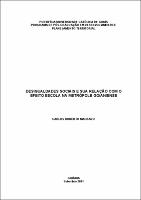| Compartilhamento |


|
Use este identificador para citar ou linkar para este item:
http://tede2.pucgoias.edu.br:8080/handle/tede/2793Registro completo de metadados
| Campo DC | Valor | Idioma |
|---|---|---|
| dc.creator | Machado, Carlos Roberto | - |
| dc.creator.Lattes | http://lattes.cnpq.br/2013954087075667 | por |
| dc.contributor.advisor1 | Moysés, Aristides | - |
| dc.contributor.advisor1Lattes | http://lattes.cnpq.br/5338712409166113 | por |
| dc.contributor.referee1 | Bernardes, Genilda Darc | - |
| dc.contributor.referee1Lattes | http://buscatextual.cnpq.br/buscatextual/visualizacv.do?id=K4727623U9 | por |
| dc.contributor.referee2 | Boaventura, Deusa Maria Rodrigues | - |
| dc.contributor.referee2Lattes | http://lattes.cnpq.br/4518779017675694 | por |
| dc.date.accessioned | 2016-08-10T10:49:48Z | - |
| dc.date.available | 2013-04-17 | - |
| dc.date.issued | 2011-09-30 | - |
| dc.identifier.citation | MACHADO, Carlos Roberto. DESIGUALDADES SOCIAIS E SUA RELAÇÃO COM O EFEITO ESCOLA NA METRÓPOLE GOIANIENSE. 2011. 91 f. Dissertação (Mestrado em Ciências Exatas e da Terra) - Pontifícia Universidade Católica de Goiás, GOIÂNIA, 2011. | por |
| dc.identifier.uri | http://localhost:8080/tede/handle/tede/2793 | - |
| dc.description.resumo | A dissertação procura entender a relação entre segregação, desigualdade social e o efeito escola na Região Metropolitana de Goiânia. As influências históricas politicamente construídas, e as ideologias que causaram o processo de segregação nas áreas onde houve um processo de desponderamento dos ativos necessários para os indivíduos, e que, caracterizam a estrutura de oportunidade e o efeito escola. Neste trabalho demonstraremos que há segregação, pois os indivíduos têm menos oportunidades educacionais e, quanto mais a cidade cresce, mais aumenta o processo de segregação urbana, separando bairros com distintas paisagens: os bairros das classes populares (trabalhadores) e os bairros ricos (elite). Devido a esse processo de segregação os trabalhadores permanecem em bairros sem muita infra-estrutura urbana (como ruas pavimentadas e arborizadas, serviços de saúde, água, esgoto e educação). A partir disso, buscamos entender como acontece na metrópole Goianiense, a questão das oportunidades educacionais, o efeito escola nas áreas segregadas. Assim, percebemos que as áreas segregadas de Goiânia vão muito além de simplesmente não existir o efeito escola, mas, também, da falta de oportunidades educacionais nas áreas segregadas. Para entender este processo de segregação e efeito vizinhança, e oportunidades educacionais em relação as desigualdades sociais utilizamos às Àreas de Ponderação Amostral, também identificada pela sigla AEDs produzidas pelo IBGE e uso corrente pelo Observatório das Metrópoles | por |
| dc.description.abstract | This thesis searches to understand the relationship between segregation, social inequality and the school effect in the metropolitan area of Goiânia. The historical influences politically constructed and ideologies that have caused the segregation process in areas where there has been a slight process of the required assets to individuals and characterize the structure of opportunity and the school effect. In this study we demonstrate that there is segregation, because some individuals have fewer educational opportunities, and the more the city grows, the more increases the process of urban segregation, separating neighborhoods with distinct panoramas: the neighborhoods of the popular classes (workers) and the suburbs (elite). Due to this segregation process workers remain in urban neighborhoods without much infrastructure (such as paved streets and wooded, health services, water, sanitation and education). From this, we seek to understand how this happens in the Goianiense metropolis, the issue of educational opportunities, and the school effect in segregated areas. Thus, we find that the segregated areas of Goiânia go farther beyond simply there is no school effect, but also the lack of educational opportunities in segregated areas. To understand this process of segregation and neighborhood effects, and educational opportunities regarding social inequalitiesusing the areas of Sample Weighting, also identified by the acronym AEDs produced by IBGE and current usage by the Observatory of the metropolises | eng |
| dc.description.provenance | Made available in DSpace on 2016-08-10T10:49:48Z (GMT). No. of bitstreams: 1 Carlos Roberto Machado.pdf: 686667 bytes, checksum: 42742681e618f7b37536fce0e2bcb9de (MD5) Previous issue date: 2011-09-30 | eng |
| dc.format | application/pdf | por |
| dc.thumbnail.url | http://localhost:8080/tede/retrieve/9023/Carlos%20Roberto%20Machado.pdf.jpg | * |
| dc.language | por | por |
| dc.publisher | Pontifícia Universidade Católica de Goiás | por |
| dc.publisher.department | Ciências Exatas e da Terra | por |
| dc.publisher.country | BR | por |
| dc.publisher.initials | PUC Goiás | por |
| dc.publisher.program | Desenvolvimento e Planejamento Territorial | por |
| dc.rights | Acesso Aberto | por |
| dc.subject | segregação urbana | por |
| dc.subject | metrópole | por |
| dc.subject | efeito escola | por |
| dc.subject | oportunidades educacionais | por |
| dc.subject | infra-estrutura | por |
| dc.subject | estrutura de oportunidade | por |
| dc.subject | estrutura de vulnerabilidade | por |
| dc.subject | efeito escola | por |
| dc.subject | desigualdades sociais | por |
| dc.subject | urban segregation | eng |
| dc.subject | metropolis | eng |
| dc.subject | school effect | eng |
| dc.subject | educational opportunities | eng |
| dc.subject | opportunity structure | eng |
| dc.subject | structure of vulnerability | eng |
| dc.subject | effect | eng |
| dc.subject | school social inequalities | eng |
| dc.subject.cnpq | CNPQ::CIENCIAS SOCIAIS APLICADAS | por |
| dc.title | DESIGUALDADES SOCIAIS E SUA RELAÇÃO COM O EFEITO ESCOLA NA METRÓPOLE GOIANIENSE | por |
| dc.type | Dissertação | por |
| Aparece nas coleções: | Mestrado em Desenvolvimento e Planejamento Territorial | |
Arquivos associados a este item:
| Arquivo | Descrição | Tamanho | Formato | |
|---|---|---|---|---|
| Carlos Roberto Machado.pdf | 670,57 kB | Adobe PDF |  Baixar/Abrir Pré-Visualizar |
Os itens no repositório estão protegidos por copyright, com todos os direitos reservados, salvo quando é indicado o contrário.




